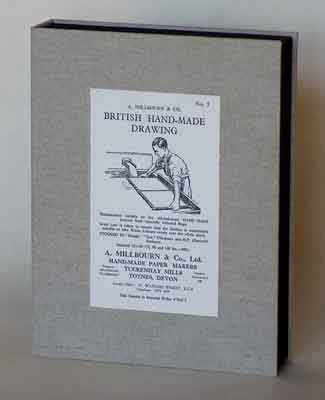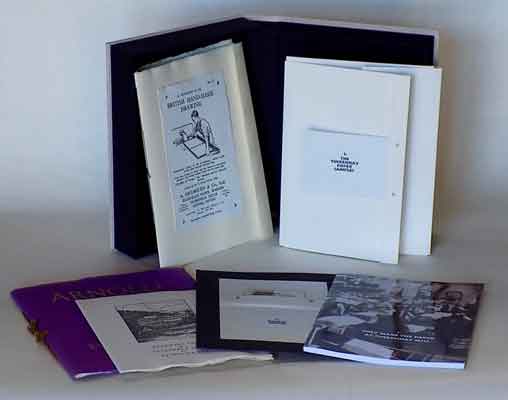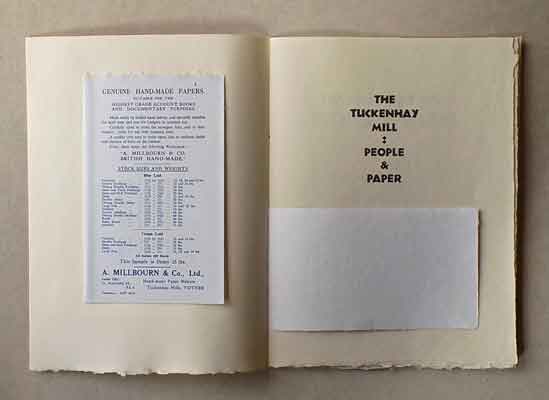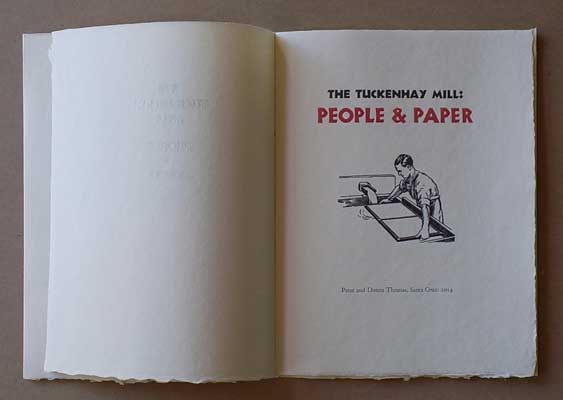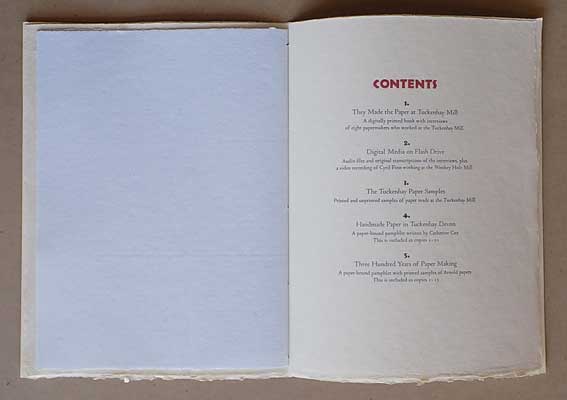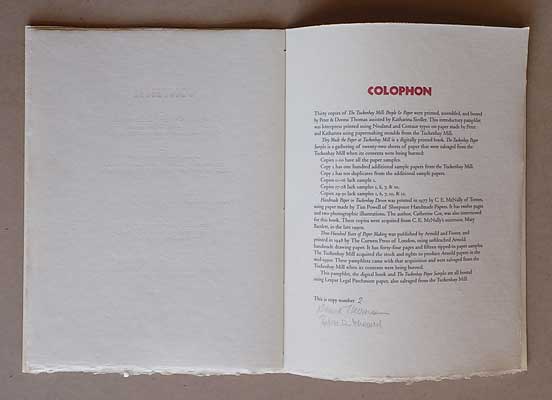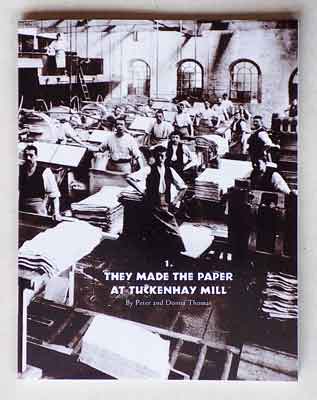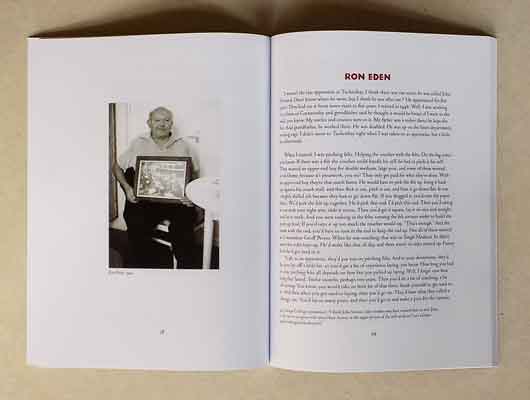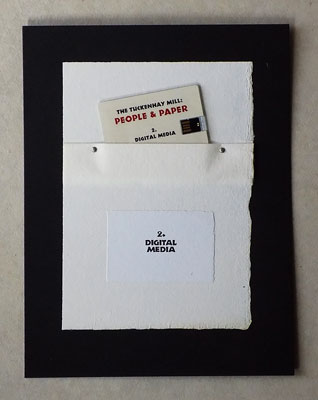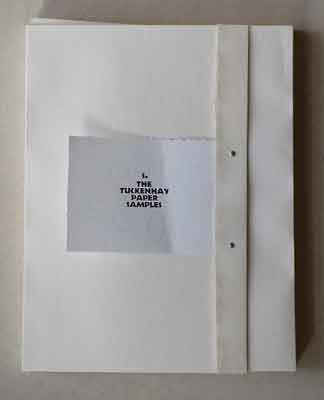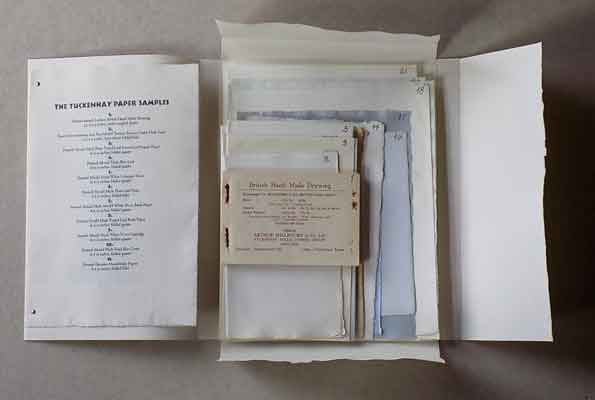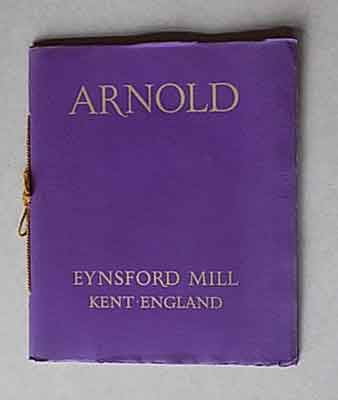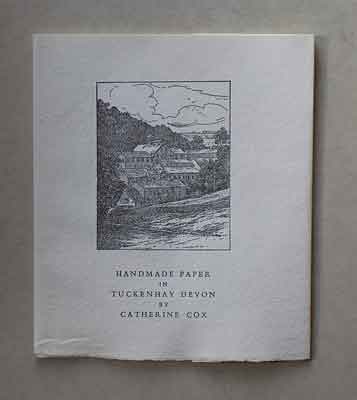PETER & DONNA THOMAS
![]() 260 Fifteenth Avenue Santa Cruz CA 95062 (831)
475-1455
260 Fifteenth Avenue Santa Cruz CA 95062 (831)
475-1455
![]()
| The Tuckenhay Mill: People and Paper (2016) Peter Thomas. 13 by 9 7/8 by 2 3/8 inches. 30 copies.
Each copy has digitally printed 100-page book with an explanation of the project, how it came to be, and edited version of the interviews. It is titled: They Made the Paper in Tuckenhay Mill Ė interviews with retired hand papermakers.
Each copy has a flash drive with the original interview recordings as .mp4 files, their transcriptions in both .doc and .pdf, and a video recording of one of the interviewees making paper at the Wookey Hole mill in Somerset, England.
Each copy has a folder, made from Tuckenhayís Lexpar paper, with 18-22 examples of handmade paper and printed ephemera from the Tuckenhay Mill.
Copy number 1-15 have a 44-page booklet titled Three Hundred Years of Paper Making. Specimens Printed on Various Papers Made at Eynsford. That was printed in 1948 at The Curwen Press, London with 14 tipped in samples on Eynsford paper.
Copy numbers 1-21 have a 12-page booklet by Kitty Cox titled Handmade Paper in Tuckenhay Devon that was printed in 1977 by C.E. Mc Nally, Totnes, on Sheepstor Handmade Paper.
Prospectus/Artists' Statement about The Tuckenhay Mill: People and Paper This book is a reliquary that holds treasured stories, audio recordings, and bits and pieces of handmade paper, both printed and unprinted, from a group of retired papermakers who lived in a little rural village, Tuckenhay, near Totnes in Devon England. The town had a mill that had continuously made by hand from the early 1800s until the mill went bankrupt in 1970. When it went bankrupt the owner ordered all the contents scrapped or burned so no one would profit from his loss. One of the workers I had met was the one in charge of the burning, and he had saved some of the things he should have burned.....let me tell you more: As a self-taught hand papermaker in the 1980s I wanted to know how apprentice-trained hand papermakers had made paper, to learn the exact motions the vatman used when dipping the mould thru the water. This desire circuitously led me to Tuckenhay where, in 1988, I met Cyril Finn, who had apprenticed and then worked as a hand papermaker at the Tuckenhay paper mill. I recorded him, his wife Joyce, and his half-sister Kitty Cox, as they reminisced about their lives working in the mill. They introduced me to other retired papermakers from the Tuckenhay Mill, and in 1988, 1990, and 1994 Donna and I returned to England and recorded their stories too. At this same time I acquired a few papermaking moulds, some mill record books and paper ephemera, from them, things that should have been burned in 1970. Perhaps fearing reprisal, all these papermakers we interviewed made us promise not to publish anything until the mill owner had died. In 2007, Kittyís grandson, Steve Cox, contacted us while building a historical website for the mill and we considered reviving the project. However, we found the millís owner was still alive, and so had to let the tapes continue to gather dust. In 2013, talking with a graduate student at the University of Iowa about meeting and recording interviews with the retired papermakers in England, we were reminded that the interviews were valuable primary source material in a field where few historians had worked, and we were again encouraged to publish the interviews. This time, after some serious detective work, we found the millís owner had passed away and we were free to proceed. I was lucky to get these stories. I didnít mean to. My initial goal was only to learn how to improve my own papermaking. I just wanted to watch Cyril work and that way learn how to properly perform the vatmanís shake. But hearing the things these retired papermakers knew about hand papermaking, I wanted to know more. I was not trained as an investigative reporter and did not know how to conduct an interview properly. I did not always speak slowly and clearly. When I became interested in another line of questioning, I would cut off their responses in mid-sentence. Sometimes there were two or three people talking at the same time. The results, when transcribed, were choppy and hard to follow. To resolve these problems we decided to remove my voice and turn the interviews into first person stories. First we sorted the transcriptions by speaker, then by the subject being discussed. We then rewrote the information, integrating my questions into the replies, merging what was duplicated, and editing what was left to create a first person story for each of the 8 people we interviewed. The text of They Made the Paper at Tuckenhay Mill first gives a short history of the mill, then tells my story of meeting Cyril and recording the interviews, and finally presents edited versions of the papermakersí stories from the interviews. A flash drive with the original audio recordings and complete transcriptions is included to give a voice to the papermakers, and allow the scholar to hear and read exactly what the papermakers said. A video recording of Cyril making paper at Wookey Hole is also there, to help the reader form a better picture of the equipment and process the papermakers are talking about in the interviews. Finally there is the paper in the Tuckenhay Paper Samples folder. It will give the reader another way, a very tactile way, to understand the raw material of the stories told in the interviews: handmade paper.
|
Back to top.
